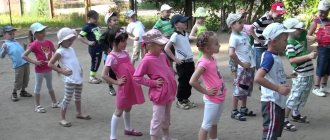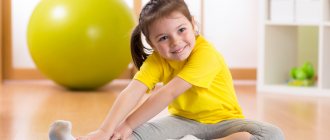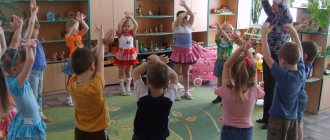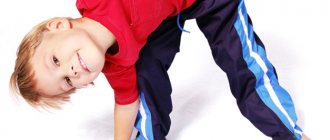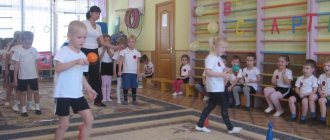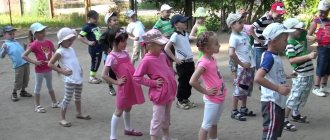Morning exercise tasks
Morning exercises can strengthen your child's muscle corset. In childhood, no matter how old he is, up to 15-16 years old. The formation of his bones and, accordingly, his muscles is underway. Therefore, it is very important that your child exercises. To prevent spinal curvature and other pathologies from developing.
Also, it strengthens the heart muscle. Normalizes breathing and increases performance. In addition, if your child is active enough, then in the very morning he will be able to spend his energy and then engage in calmer games.
Warm-up
Warming up helps warm up the muscles and avoid subsequent pain. It is important to follow the correct order so that the load does not damage the children’s muscles and ligaments:
- start with fast walking;
- then load the arms, belt, back;
- the next part is strengthening the leg muscles;
- the active part includes running and jumping;
- finish with exercises to calm breathing: walking, inhaling and exhaling while raising your arms, etc.
The purpose of morning exercises
Morning exercises are physical exercises whose purpose is to increase the overall tone of the body. It gives you a boost of energy for the rest of the day. And your children's muscles become stronger.
From this we can conclude that its main purpose is to awaken your body and get a boost of energy for the rest of the day.
How to prepare a child for exercise?
Of course, it’s difficult to get a child out of bed ahead of time, especially “for some kind of exercise.” This wonderful habit must be instilled gradually.
As you know, for a habit to become established, it takes about 15-30 days of regularly repeated actions. That is, after 2-3 weeks of such activities, your child will already be drawn to them.
Without attitude - nowhere. Therefore, the most important thing in forming this habit is to tune in and find motivation.
In addition, it is important that the child’s exercises change periodically (children at this age get tired of the same type of training too quickly).
And don’t forget to praise your child and encourage any physical activity in every possible way.
Exercises for morning exercises
Morning exercises for children. A set of 5 exercises will consist of: This is one of the quick activities so that if you oversleep, you can still complete the activity.
There are a number of exercises that are performed to musical songs. Namely, if you set a goal, you can find many songs that already tell you what to do. However, we will simplify the task for you and now we will write a set of exercises for beginners, consisting of 5 exercises. You can perform it to the music, so it will be much more interesting for your child to study.
- Walking in place
The main thing is to make sure that your legs are not too far apart. His hands were on his belt. The child must do the exercises correctly. Therefore, it is best to do everything next to him.
- Now that you have done the classic walk. Start walking with your knees high.
- Shallow squats with arms extended forward
This exercise helps strengthen your leg muscles and joints.
- Tilts
Feet shoulder-width apart, bend forward, right and left.
- Jumping on one leg
Hands on the belt. First, have your child jump on his left leg, then on his right.
Remember that charging does not take long. Maximum 20-30 minutes. And such as was written above, it takes only 10 minutes. Therefore, you don't need to do a lot of repetitions with a lot of approaches.
Morning exercises are called that because they are performed in the morning hours of the day. As a rule, immediately after waking up and has a complex effect on your body.
Therefore, it is necessary to do morning exercises in the morning.
The purpose and order of performing the exercises does not play any role. However, initially you should perform fairly gentle exercises. This way your body will warm up slightly and then you can do more active exercises.
Morning exercises in the senior group and elementary school are no different from each other. Except for the time. In kindergartens, children are not so diligent, so the amount of exercise is less. But in elementary school there are more exercises and they take longer. Below we will give an example of exercises that you can perform at any age and at any time. They can also be alternated.
Little tricks for adults
Children's morning exercises should be made a mandatory home tradition from a very early age. At the very beginning, it is better for adults not just to show the child what and how to do, but to take an active part in the process itself. Extra activities won’t hurt parents either, and it will be much more interesting for their son or daughter.
Parents need to understand:
- Children involuntarily copy the movements, behavior, and habits of adults. If you set a goal to raise a healthy, active child, you should start with yourself.
- For the little sleepyheads who are too lazy to get out of their cozy crib in the morning, you can come up with a game based on your favorite fairy tale or animated film, and choose suitable music.
- No need to take it right off the bat: no one is training champions and record holders yet. It is enough if the first complexes are designed for 5-7 minutes. Only gradually they should be expanded to 15 and then 20 minutes, but no more.
- If possible, exercises should be carried out in the fresh air (at least in the warm season). If you focus on studying in an ordinary apartment, then the room must be ventilated. As a result, the classes will be successfully combined with such an important element of general health improvement as hardening.
- On some day, the child may try to ignore classes. Nothing wrong with that. Adults should still carry out the usual complex - in a truncated format, on their own. Perhaps the baby will immediately join mom or dad.
- A good incentive for kids is to take part in physical exercises with their favorite toys and dolls. They can be used either as partners or as projectiles.
- Exercises need to be changed, but not all at once, but one at a time. This way you can reduce the risk of getting bored with constant movements.
When starting to introduce morning exercises for children, you should not force things. The child should have fun and not accumulate negative emotions. If one method does not work, you just need to start looking for another.
MORNING EXERCISES FOR CHILDREN 4-5 YEARS OLD. 6 charging options. SCHOOL OF EARLY DEVELOPMENT.
Charging at a preschool educational institution
For those who don't know what a dhow is. This is preschool education averaging, and in other words kindergarten.
In preschool institutions, physical education is held every day. Therefore, if your child goes to kindergarten, you may not exercise at home. However, on weekends or holidays you can continue to do the exercises.
What exercises are done in kindergarten? No matter what group your child is in, the exercises are always the same. It doesn’t matter if you’re in the middle group or the senior group.
General developmental. First they stretch their neck, shoulders, and arms. After the pelvis, knees, ankle. Circular rotations are performed.
Then we march in place. We squat, jump with our feet together and jump on one leg.
Mill exercise. Turn the torso to the sides.
What to do if your muscles hurt after gymnastics
Typically, muscle pain appears as a reaction to excessive exercise. However, children's gymnastics does not involve an abundance of strength exercises, so there should be no pain in the muscles. If the load corresponds to the child’s age, but pain still appears, then perhaps the reason is the following:
- lack of water increases the likelihood of muscle spasms, so make sure that the child drinks water before exercise and that the room is not too hot;
- perhaps the problem is a lack of potassium and magnesium, so review the children's diet and add foods containing these microelements to it: beans, dried apricots, buckwheat, potatoes, spinach, pumpkin, oranges;
- muscle and joint pain may appear as a harbinger of a viral infection.
There is no need to stop exercising, as physical exercise speeds up metabolism and improves muscle condition. You just need to reduce the intensity of the load. A massage and a warm shower will help relieve excess muscle tension.
Important! The cause of pain can be not just overexertion, but muscle rupture. Then any movement in this area will cause acute pain. If this happens, you should definitely consult a doctor.
To ensure that charging brings only positive results, follow these simple tips:
- Remember that exercise should be regular, as muscle pain occurs if you begin to exercise intensively after prolonged inactivity.
- Pay attention to chronic illnesses and health conditions: If you have any chronic illness, discuss your planned exercise routine with your doctor. If your child is lethargic, has a sore throat, headache, or other signs of an impending infection, postpone activities until he or she has recovered.
- Don't force it. Exercises are done, among other things, to create a positive emotional background. And if on some day the little man refuses to do the exercises, then don’t push. Analyze the reasons: perhaps the movements are too difficult, perhaps the child is tired and cannot gather his strength, or he is simply tired of doing the same thing. Talk about the reasons for failure, make adjustments and try again.
- Follow the order of the exercises: light warm-up movements first, and then the main part.
Exercises for children in the preparatory group
- Bend forward towards your feet
Starting position: standing, legs together. We reach down with our hands to touch the floor or toes.
- Bend the torso to the sides
- Bend forward backward
Feet slightly wider than shoulder width, bend down towards your feet. The arms are straight, and then we stretch first forward and then back between the legs.
- Doing the splits
Full length portrait of happy young pregnant fitness model in sportswear, doing yoga, pilates training, Wide-Angle Seated Forward Bend pose, Upavishtha Konasana, white background, studio, isolated
We sit on the floor, spread our legs to the sides and alternately stretch, forward, right, left.
- fold
We connect the legs together. We continue to sit on the floor, inhale and, as we exhale, bend our torso forward. So that your stomach lies on your knees. However, we do not lift our knees off the floor.
Exercises for children in the preparatory group are compiled based on the characteristics of your children. They are all individual. However, the ones we have written are the most suitable for everyone. They can also be done if you want to do some stretching.
Morning physical moment. Video.
All the best and good luck. Start doing morning exercises right today and after a while your child will do it independently without your supervision and without your help.
This article showed you the exercises that exist, the purpose of morning exercises. How you can create exercises for yourself. Are there any differences in exercises for the middle group or the senior group, and so on. Read on to our articles and learn a lot of new things related to sports, health and a healthy lifestyle.
Post Views: 1,012
Individual approach
You can organize morning exercises for children in different ways. A little desire and imagination - and parents develop their own complex, which is not taught in kindergarten or school. This approach should be built taking into account the interests of the boy or girl, their capabilities and characteristics.
As the preschooler grows, the time of classes and their dynamism increases. It's time for sons to be given strength exercises, but girls can spend more time stretching. Warm-up slowly turns into more complete activities, which can later turn the child to sports.
In some exercises, children will need direct help from adults or their direct participation:
- Abs pumping. At first, you need to hold the child’s legs or find suitable support.
- Full push-ups from the floor.
- Somersaults forward and backward.
- Headstand and handstand against the wall and then on the mat.
- Working with a spring expander with your hands and feet.
- Squats with different positions of the legs: together, shoulder-width apart, widely spaced.
- Throwing your legs behind your head in a lying position.
- Boxing for boys and tiptoe dancing for girls (although both can be used regardless of the gender of the child).
- Rolling from head to pelvis and back with bent knees (hands behind head).
- Leg twist with bent knees (standing).
- Single and double bicycle in a prone position, alternate and joint leg raises.
- Bent-overs with dumbbells. Instead of store-bought shells, you can use plastic drink bottles filled with water.
All strength exercises should be done 12 to 16 times. If necessary, they can be divided into several approaches. Finally, take a cool shower or douche.
Exercises for children Sunny.mpg
Eastern ornament
New approaches imply the inclusion in regular complexes of not only breathing practices, but also elements of yoga, wushu, and some other oriental martial and health techniques. At first, advanced instructors are not needed here, because initially these directions were created by ordinary people for everyday use.
To organize a more interesting and useful process at home, you should try :
- Place your hands behind your back, secure a stick under your elbows (a regular mop will do). Without releasing the stick, walk, squat, bend, and make smooth turns of the body.
- Bend your arms, raising them so that your clenched fists are at chest level with the inside facing up. Throw them forward sharply. Bring it back so that the knuckles are up.
- Bend your fingers. Raise your palms to eye level with the inside facing your face. Raise your leg bent at the knee. Hold the position for a few seconds. Lower your leg. Make scratching movements with your palms from top to bottom.
- Spread your legs and bend them slightly. Straighten one arm parallel to the floor. Place the second one behind your head in a half-bent position. Step out, half crouching, to the side and at the same time move your arm forward from behind your head. Do the same in the other direction, changing hands.
- Place your right hand on your left shoulder with a half-turn of your torso - inhale, back - exhale. Change shoulder and arm.
- As you inhale, reach the calf muscle as low as possible, straighten as you exhale. When you feel comfortable with the limbs of the same name (right and left), do the same movements crosswise.
Proper breathing against the backdrop of movements that develop the body brings double benefits. Over time, such a complex can successfully replace more dynamic exercises.
The importance of gymnastics for child development
Special classes and massage will help compensate for the lack of physical activity and will have a general strengthening effect on the child’s body. And also, the gentle touches of mother’s hands, games and exercises bring great pleasure to the baby, creating a strong emotional connection between him and mother. With the help of regular gymnastics, any healthy child will become even more perfect, and a child who is lagging behind in development will be able to quickly catch up with his peers.
Even in the maternity hospital, mothers are advised to stroke the baby and lightly move clockwise along the tummy. At the same time, the warmth of mother’s hands is of great value to a child, because now the baby only needs the presence of mother and her tenderness.
An important step in caring for newborns is gymnastics for newborns. Considering the age of the baby, physical exercises are required, which are of great importance for the development of the child. Naturally, the more the child moves and performs various movements, the better his brain will develop.
Physical exercise promotes the development of the baby's lungs. Gymnastics has a beneficial effect on the appetite, digestion and sleep of a newborn. Gymnastics promotes the growth of bones and muscles, increasing blood flow to them.
In order for gymnastics to bring only benefits to the baby, we must not forget about the characteristics of the musculoskeletal system of newborns. The muscles, ligaments and bones of the baby are not fully formed, they are too tender and fragile, which means that the physical exercises performed during gymnastics must correspond to the age capabilities of the child.
Before starting gymnastics with your baby, it is better to consult a doctor, learn some exercises, and get useful recommendations.
Video: Fun exercises for a child
Remember that it is impossible to force a child to exercise like hard labor. It is important that he himself wants to work with you. Therefore, first of all, we demonstrate the importance of charging with our own example.
Children at this age are already excellent at thinking and analyzing, and if you are constantly lying on the sofa, growing a belly, then you simply will not be able to force your child to study - personal example is more effective than all other methods.
The site Colady.ru thanks you for your attention to the article - we hope that it was useful to you. Please share your feedback and tips with our readers!
Exercises for children under one year old on a fitball
A fitball is a large gymnastic ball. With its help, you can not only tighten the mother’s figure after childbirth, but also develop the baby. Classes can begin as early as two weeks of age. Gymnastics for children under one year old on a fitball is extremely useful:
- Such exercises reduce tone and relax the intestinal muscles, which is the prevention of colic.
- A slight vibration during movements is an excellent stimulation of many important organs of the child.
- The vestibular apparatus develops.
- Exercises bring a lot of positive emotions to the child and mother.
Rules for exercising on a fitball
- It is better to choose a ball diameter of 60-75 cm.
- Do not pull the baby too hard by the hands and feet. This can cause dislocation.
- The child must be carefully held by the back, buttocks, stomach, and forearms.
- There is no need to make too large a range of movements - you may accidentally drop the baby.
- It is better to accompany the classes with music, singing or telling nursery rhymes.
- If the baby does not like it, he cries, you must immediately stop charging.
- You cannot exercise on a fitball if the child’s umbilical wound has not yet healed or the baby is not feeling well.
For very young children who have not yet turned one year old, the following exercises are suitable:
A fitness ball is a universal equipment for the whole family. You can come up with or find hundreds of exercises on the Internet using this sports accessory. With its help you can work not only with a newborn, but also with a child of any age.
It doesn’t matter what exercises the mother chooses for the baby - with a ball or classical gymnastics. Any physical activity will bring great benefits to the baby. The main thing is to remember that gymnastics should be based on three principles: regularity, accuracy and the child’s pleasure.
Physical activity has a huge impact on the development of a child. With the help of various movements, the baby learns about the world around him, grows up, and develops normally. Thanks to movements, the baby’s blood circulation improves and metabolic processes are regulated. From birth, babies really need physical activity, and that means gymnastics. All parents want their children to grow up healthy and happy. The sun, fresh clean air, varied and nutritious food, the love and attention of adults are the key to a child’s health, not only physically, but also mentally. Currently, the importance of physical activity for young children is often underestimated. Insufficient physical activity is very unfavorable both for the baby’s health and for the formation of his personality. This problem is especially acute for children who permanently live in the city and spend most of the day indoors.
